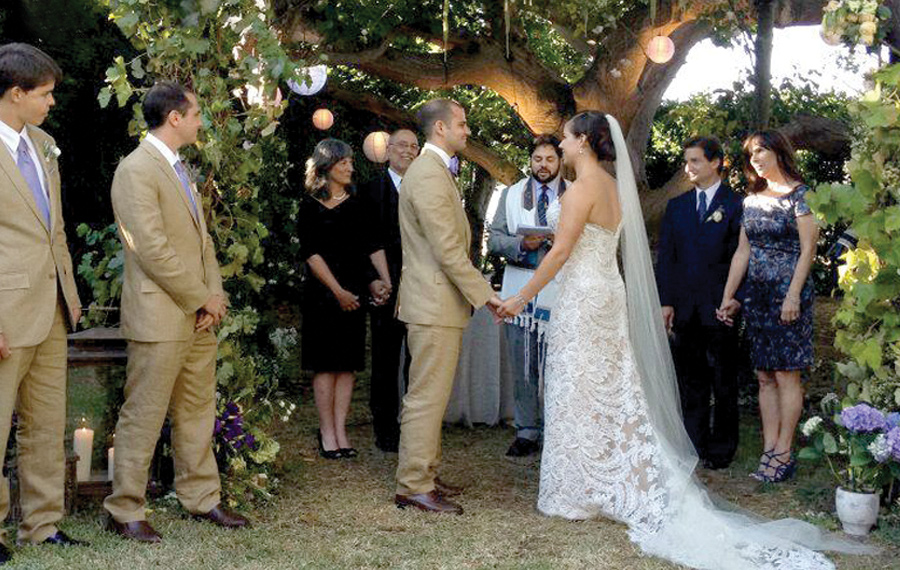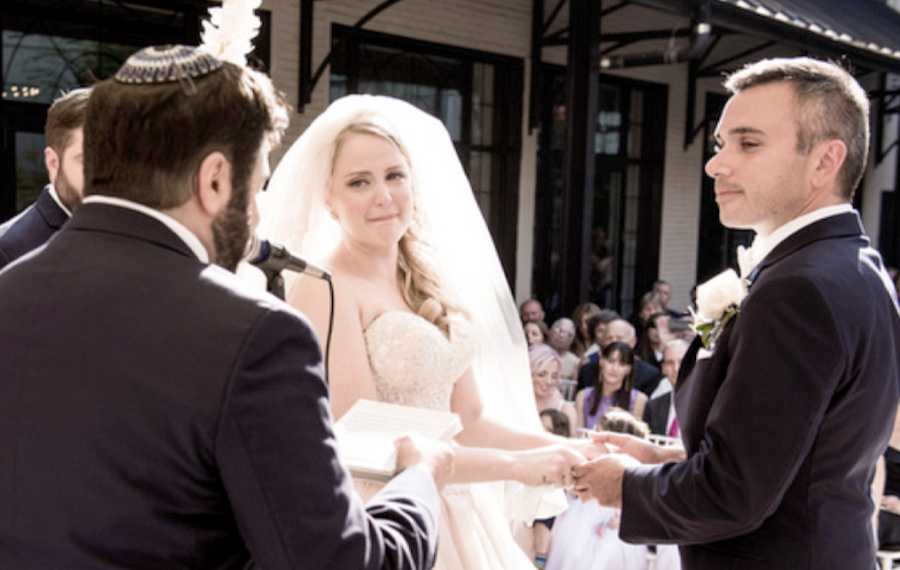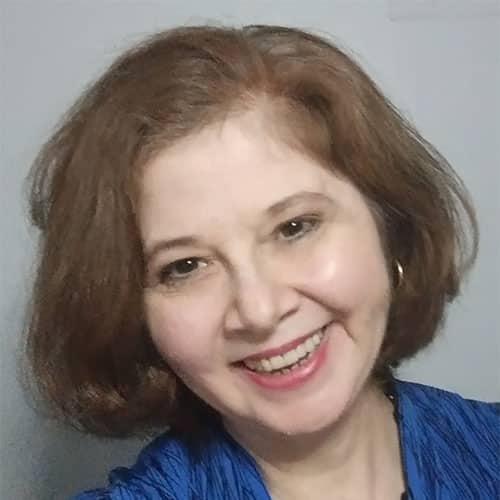 Todd Shotz officiates at Moe Davidowitz and Lucinda Anguay’s wedding with nods to Anguay’s Hawaiian heritage. Photo by Martin V Photography
Todd Shotz officiates at Moe Davidowitz and Lucinda Anguay’s wedding with nods to Anguay’s Hawaiian heritage. Photo by Martin V Photography
Wedding officiant Todd Shotz takes great pride in creating meaningful one-of-a-kind Jewish wedding experiences. Limiting himself to three to five weddings each year, he puts a great deal of time and energy into working with and getting to know the people he marries. Some of those weddings involve interfaith couples seeking a ceremony from a Jewish perspective.
Shotz is the founder of Hebrew Helpers, a nationwide Jewish studies program that provides personalized education to students of all backgrounds and affiliations. He also is a Jewish educator with more than 20 years’ experience. He has officiated weddings and other life-cycle events for almost 10 years in places as far-flung as Venice, Italy, and as close as Santa Monica.
The first step in creating a meaningful wedding ceremony, he said, is to find out how the couple wants their wedding to feel. “They usually will always say something about, ‘We want it to be moving, but we don’t want it to be too long.’ They also usually want to laugh and have it feel somewhat informal.”
“It’s so important to me to make sure we create a ceremony that’s authentic to that couple and their families, while at the same time paying tribute to tradition.” — Todd Shotz
Between his first and second meeting with each couple, Shotz encourages them to write a mission statement for their relationship. “It doesn’t have to be a formally written paragraph,” he said. “It can just be bullet points or words that they keep falling back on [about what makes] their relationship unique or how they feel about each other.”
He said for one couple the word “companionship” was significant, while another used the word “outdoorsy” to describe their bond. “What I hope is [the mission statement] will help them to make decisions as they go forward in the relationship. It also helps them to decide the rest of the ceremony.”
For the wedding itself, Shotz sticks with a template on how a Jewish ceremony works and then personalizes the running order. He works with the couple to determine how they want to interpret each moment, from the rings and the readings to how many cups of wine for the ceremony and whether the couple wants to be wrapped in tallit.

“It’s me fostering a unique ceremony based on what they are looking for and within reason,” he said. “I want to make sure it still feels like a Jewish ceremony, because that’s why they came to me, rather than a secular justice of the peace.”
Another big part of the decision-making process that Shotz helps the couple with is deciding on how many of the seven traditional blessings that are recited under the chuppah to use. Most couples, he said, keep the opening blessing: “We commemorate this occasion with a glass of wine, fruit of the vine that is shared today between these two hands and these two lips, as the first of many celebrations a life shared will bring,” and the closing one: “And we celebrate together with the bride and groom the joy in song, pleasure, delight, love, sisterhood, peace and companionship. The sound of joy and the sound of gladness in the voice of the groom and the voice of the bride, the sound of the jubilance of couples from their wedding canopies and at their feasts of song. We sing of the happiness of the groom and the bride.”
However, at the request of one of his couples, Shotz began personalizing the other five blessings. “The other blessings are really somewhat vague,” he said. He has since written more than a dozen custom blessings that talk more about relationships.

Whenever he creates a new version of the blessings, Shotz translates them into Modern Hebrew. He then sets them to a traditional tune that he sings a cappella during the ceremony. He said the best part about doing this is that the translations reflect the couple’s relationship and they can involve their friends and family in the ceremony.
After 20 years together, Lucinda Anguay and Moe Davidowitz finally tied the knot in October in Southern California. After Anguay saw Shotz perform at a bar mitzvah ceremony in Israel, she asked him to officiate at their Jewish wedding and incorporate her Hawaiian heritage.
Shotz recruited one of Anguay’s nieces, who had studied the traditional Hawaiian language in high school. She helped him come up with a Hawaiian prayer — a beautiful proclamation of love — to open the ceremony, which he did in Hawaiian and English.
“It immediately made the family and friends who traveled from Hawaii feel included,” Shotz said. “In our modern age, so many different types of couples are coming together, not just interfaith, but Jewish couples with different backgrounds. It’s so important to me to make sure we create a ceremony that’s authentic to that couple and their families, while at the same time paying tribute to tradition.”























 More news and opinions than at a Shabbat dinner, right in your inbox.
More news and opinions than at a Shabbat dinner, right in your inbox.